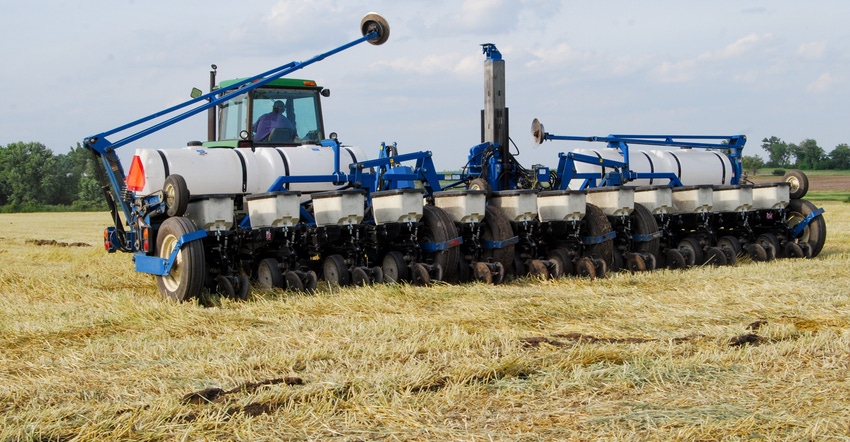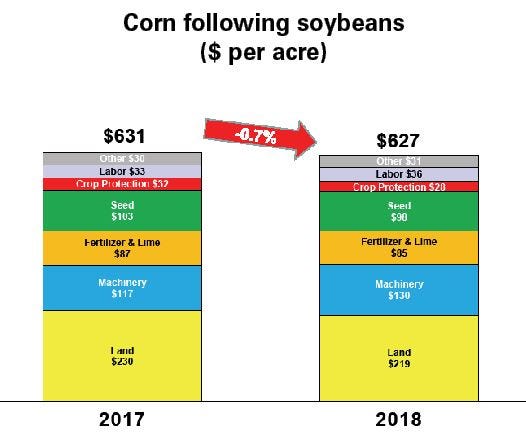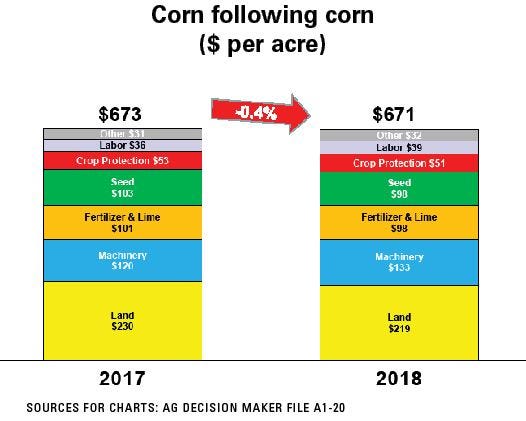February 2, 2018

The average cost of soybean production in Iowa is expected to fall slightly this year, but corn costs will remain unchanged, according to the annual report “Estimated Costs of Crop Production in Iowa — 2018,” published by Iowa State University Extension and Outreach.
The report shows soybean production costs falling by $10 per acre this year, or about 2.1%, from 2017 levels. However, the cost of corn production is projected to decline by less than $5 per acre, or less than 1%.
The total cost per bushel of soybeans is projected at $9.46 for the herbicide-tolerant variety and $9.41 for non-herbicide-tolerant beans. The total cost per bushel of corn is projected at $3.48 for corn following soybeans and $4.07 for corn following corn.
Average costs figured
These cost estimates are representative of average costs for farms in Iowa. Very large or small farms may have lower or higher fixed costs per acre. The annual estimates are to be used as guidelines to help you compare and figure your own costs for your farming operation.
For example, if you own the land and are interested in calculating your accounting cost of production rather than your economic cost of production (which includes the opportunity cost of not renting out your land), then your land cost will likely be much smaller than the cash rent equivalent included in the report.

Alternatively, if you are producing crops in leased acres and your cost structure is similar to the one used for the report, but your expected yield is much higher, then your projected cost per bushel will be lower than the published one.
A moderate decline in herbicide, fertilizer, lime and seed prices, as well as lower cash rents, are expected to barely offset increases in machinery, labor, insecticides and crop insurance costs for corn.
In particular, machinery costs in corn production are expected to increase by $13 to $14 per acre, due to higher projected diesel and gas prices in 2018. Soybean costs would be less affected by higher fuel prices due to the less intensive nature of machinery used in soybean production.
Crop costs down
The accumulated declines in total costs of corn and soybean production between 2012 and 2018 amount to 19% and 14%, respectively. However, these cost reductions are dwarfed by the 53% and 35% reduction in corn and soybean prices, respectively, between 2012 and 2017.
When using the ISU cost-of-production estimates for 2018, keep several things in mind.

First, fertilizer and lime costs include volume and early-purchase discounts.
Second, farmers paying land rents higher than the ones projected in the report might face higher costs of production.
Third, in order to compare budgets through time, ISU calculations are based on a fixed rate of input use. If a farmer switches to seeds with fewer traits, or skips a field pass, then the ISU report will be overestimating the true cost for that farmer.
Finally, crop budgets are calculated under the assumption that farmers target the same yield year after year.
Breaking even in 2018
Lower costs of production along with a well-planned marketing plan have the potential to result in small but positive profit margins in 2018.
Using USDA price projections for 2018-19 (as of Jan. 12), a rented acre of corn following soybeans would need to produce 190 bushels of corn to break even, and a rented acre of genetically modified soybeans would need to produce 50.31 bushels of soybeans to break even.
However, a rented acre of corn following corn would need to produce 203.3 bushels of corn to break even. Of course, the margin of error in these projections is directly proportional to the margins of error on projected yields, costs and prices.
Given such uncertainties, it is highly recommended that producers visit with trusted agronomists on how to cut costs without hurting revenue potential.

Knowing the operation’s cost per acre is critical for creating solid marketing plans and making the necessary arrangements to cash-flow your operation in 2018, such as securing operating loans, restructuring machinery or real estate loans, and adding nonfarm income.
Your cost of production
ISU cost estimates represent typical costs and are only intended to be guidelines. The publication Estimated Costs of Crop Production in Iowa — 2018 has information to help you figure your cost for your farm.
Actual costs will vary considerably from farm to farm and can be entered in the column for “Your estimates.” Electronic spreadsheets for developing crop production budgets are also available on the Ag Decision Maker website.
Plastina is an ISU Extension economist. Contact him at [email protected].
About the Author(s)
You May Also Like




